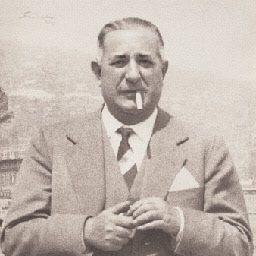Buccellati

Buccellati (founded 1919)
Buccellati, Mario (1891 – 1965)
Structurally engraved surfaces reminiscent of textures is the trademark of Italy's most famous and internationally admired jeweller.
The Italian firm of Buccellati can trace its jewellery trade origins back to the mid-eighteenth century to Contardo Buccellati, who worked as a goldsmith in Milan.
Born in Ancona, a twelve-year old Mario Buccellati begins his apprenticeship in 1903 at the prestigious Beltrami & Beltrami in Milan. Sixteen years later he buys the company and changes its name to Buccellati and opens his first boutique.
He comes up with new engraving techniques such as
rigato (parallel lines on the surface that evoke a special lustre effect)
, telato (a structure of hatched lines that imitate a surface of linen cloth)
, segrinato (engraving lines in all possible directions as overlapping structures)
, ornato (engraving organic leafs, flowers and animals resembling decorations)
and modellato (a very filigree engraving technique that uses miniature three-dimensional designs to decorate seams of objects). He creates pieces with surfaces imitating various cloth structures, such as silk, damask, tulle, lace or linen.
Large and unusual stones are frequently used. Some of the larger cabochons in their wartime designs are chipped and damaged. Precious stones are set into jewellery upside down. Buccellati takes great pride in the fact that their jewellery is “instantly recognisable”. Since 1934 all pieces are stamped with the hallmark *15 MI.
Dubbed “The Prince of Goldsmiths”, the outlandish personality of Mario brings the company almost immediate acclaim. At the 1920 exposition in Madrid, Buccellati is completely sold out and begins attracting clients from the Spanish aristocracy and the royal family. He is invited to have his own exhibition in Madrid. A well-funded and loyal clientele internationally but also at home supports his success.
The early Buccellati designs are inspired by Renaissance art and become well known for their brushed and textured gold in intricate designs. Buccellati also frequently mixes white and yellow in their metals, such as silver or platinum with yellow gold. The admired Buccellati compacts are produced from the 1920s to the 1950s. When World War II limits the supply of gold, Buccellati uses copper instead with Dutch gold added on top, maintaining their supply of jewellery and compacts when many other jewellery firms are struggling to survive.
Four of Mario’s five sons join the family company and oversee its international expansion in places such as New York, Hong Kong and Japan. After Mario’s death in 1967, the Buccellati company continues its international growth and is still owned and run by third-generation members of the family today.
Buccellati, gegründet 1919
Buccellati, Mario 1891 – 1965
Markenzeichen von Italiens bekanntestem, international anerkanntem Juwelier sind Struktur-Gravuren, an Texturen erinnernde Oberflächen.
Die Wurzeln des Hauses Buccellati in Mailand reichen bis ins 18 Jahrhundert zurück. Der 1891 geborene Mario, beginnt mit 12 Jahren seine Karriere als Lehrling bei der renommierten Firma Beltrami&Beltrami in Mailand. 1919 kauft er das Unternehmen und eröffnet das erste Geschäft unter eigenem Namen und arbeitet für die High Society Mailands. Diademe und seine Abendtaschen aus mit Edelsteinen und Perlen bestickter Seide und Samt sind gerade sehr gefragt. 1924 eröffnet er eine Boutique in Rom, 1930 in Florenz. Buccellati vertritt die Formensprache des Art Déco in Italien. Seit 1934 sind alle Stücke mit einem Stempel versehen ( Stern 15 MI ). Große und ungewöhnliche Steine werden verwendet. Um im Geschäft zu bleiben, verwendet Buccellati während des Krieges vergoldetes Kupfer und beschädigte Steine, die er seitenverkehrt fasst. Charakteristisch sind im Haus entwickelte Gravuren. Es werden Stücke kreiert, deren Oberflächen verschiedene Stoffarten wie Seide, Damast, Tüll, Spitze oder Leinen imitieren. Die frühen Stücke Buccellatis sind hauptsächlich von der Renaissance beeinflusste Handwerkskunst und Dank den besonderen Strukturgravuren meist leicht zu identifizieren. Ebenfalls typisch sind das Gemisch von verschiedenen Metallen wie Silber und Gold oder Platin und Gold . Zu den Spezialitäten des Hauses gehört ein umlaufender Bandring. „Verette“ wird in unzähligen Varianten ausgeführt.
1951 eröffnet er mit Hilfe seines Sohnes Luca ein Geschäft in New Yorks 51. Straße, das von der Nachkriegsgesellschaft schnell angenommen wird. Seine neuesten Kreationen sind Ringe, unterschiedlich in Steinen, Farben und Gravuren. 1965 stirbt Mario in Mailand. Lorenzo und der 19 Jährige Gianmaria übernehmen das Geschäft. 1968 arbeitet Buccellatti für die Schauspielerin Candice Bergen und schafft es aufs Vogue Cover. Auch Maria Callas zählt zu den wichtigen Kunden; wie auch Päpste und diverse Königshäuser. 1973 gründet Gianmaria, der sich mittlerweile von seinen Brüdern als Mitinhaber getrennt hat, zusammen mit anderen italienischen Juwelieren das Italienische Gemmologische Institut. 1977 tritt Claudia Buccellati in die Firma ein. 1979 eröffnet Buccellati ein Geschäft an der Place Vendome in Paris. 1991 -1994 entwirft Buccellati für die Mailänder Scala. Bis heute ist das erfolgreiche Haus Buccellati in Familienbesitz.
Von Mario Bugcellati entwickelte Techniken der Strukturgravierung sind:
- Rigato – parallele Linien auf der Oberfläche, die einen besonderen Glanzeffekt hervorrufen
- Telato – schraffierte Linien, die eine Leinenoberfläche imitieren
- Segrinato – Gravurlinien in alle möglichen Richtungen, die sich überlappen
- Ornato – Ornamente, die sich an organische Formen, etwa Blätter, Blumen, Tiere, anlehnen
- Modellato – sehr filigrane Graviertechnik, die dreidimensionale Designs en miniature aufgreift